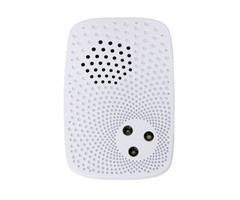DSC PowerG Sirens for Your Home or Business
Posted By Michael GorisOne great thing about owning a PowerG Security System is that it is super easy to add a wireless siren. DSC manufactures an indoor model and an outdoor model for PowerG users. Whether you are looking for a DSC NEO Wireless Siren or a new siren for an IQ Panel 2 Plus, we have you covered!
 |
 |
 |
The two (2) sirens in the PowerG lineup include the DSC PG9901 Indoor Alarm Siren and the DSC PG9911B Outdoor Alarm Siren w/ Strobe. Both will easily pair with any system that supports PowerG Sensors. These systems include the Qolsys IQ Panel 2 Plus, the DSC PowerSeries NEO w/ added PowerG Transceiver, and the DSC Iotega Security System. Both sirens work great, and they can make a nice addition to nearly any compatible alarm panel.
The Qolsys IQ Panel 2 Plus and the DSC Iotega already include their own built-in sounders that will activate during alarm events. But if you are using the system in a larger home or business, or if you find that the internal sounder isn't loud enough, then you might consider adding an external siren as well. Meanwhile, the DSC PowerSeries NEO Systems are wired panels that are typically paired with hardwired sirens. But if you want to skip the process for wiring a siren, then adding a wireless PowerG Siren can be the perfect solution.
There are two (2) main benefits to adding an external siren with a security system. The first is that most external sirens are louder than the internal sounders built into alarm panels. The Qolsys IQ Panel 2 Plus and the DSC Iotega both have internal sounders rated at 85 dB. The DSC PG9901 and the DSC PG9911B are both rated at 110 dB. Remember that volume increases exponentially with the decibel (dB) rating, so you are certainly getting a major increase in volume output with a DSC PowerG Wireless Siren.
The other major benefit to adding an external siren is that it spreads the sound out during an alarm event. Just because you add an external siren to your wireless system does not mean that the system's internal siren will stop functioning. Instead, both the system's internal sounder and the added siren will activate during alarm events. If you have the external siren in a different area, then you can really spread the sound out. This can be crucial for making sure that everyone on the premises is alerted.
Sirens activate during intrusion, fire, and carbon monoxide (CO) alarms on a system, unless the alarms are specifically set to silent. There are many purposes to alarm sirens, and every system should have one set up. First and foremost, a siren alerts building occupants to let them know that there is danger and that they need to evacuate immediately. A good alarm siren can mean the difference between life and death in many situations.
Sirens also provide assistance to emergency responders, such as police officers, firefighters, and emergency medical technicians. In the heat of the moment, it can be difficult for a responder to determine which home or business is experiencing an emergency. A siren helps eliminate this issue, as the emergency responder will know to go to the location where the siren is coming from. Lastly, sirens are useful during intrusion alarms, as they will often scare off an intruder and prevent them from sticking around to cause more property damage. This is why every security system should have a functional siren set up and configured. And if you have a larger home or business, then setting up multiple alarm sirens is probably in your best interest.
For basic indoor use, the DSC PG9901 is an ideal option. This DSC Indoor Siren produces sounds of up to 110 dB, which is roughly as loud as an industrial grade chainsaw or a live rock concert in a typical venue. If you need a siren for outdoor use, then you should go with the DSC PG9911B. This siren also operates at 110 dB, but it is built to withstand an outdoor environment with its IP55 protection rating. The DSC PG9911B also includes a built-in strobe light, which can be a nice visual indication of an alarm. Please note that some jurisdictions may have restrictions on the color of strobe lights you can use. Make sure to check local laws and see if blue strobe lights are allowed in your area.
Both the DSC PG9901 and the DSC PG9911B are available from Alarm Grid. We're happy to help you get started with a new PowerG Siren. If you have any questions about the DSC PG9901, the DSC PG9911B, or any of the other products on our site, please contact us at support@alarmgrid.com. We operate support hours from 9am to 8pm ET M-F. We look forward to hearing from you!








